Effects of Long-Term Static Bending Deformation on a Barrier Thin Film for Flexible Organic Optoelectronic Devices
Abstract
:1. Introduction
2. Materials and Experimental Procedures
2.1. Materials and Specimen Preparation
2.2. Static Bending Test
2.3. WVTR Test
2.4. Microstructural Analysis
3. Finite Element Model
4. Results and Discussion
4.1. Effect of Static Bending
4.2. Failure Analysis
4.3. Numerical Analysis
5. Conclusions
- For both tensile and compressive bending of a 20-mm curvature radius, WVTR values are stable for 1000 h. Bending with a radius of 20 mm does not deteriorate the barrier film’s performance.
- For tensile bending of 10-mm and 5-mm curvature radii, no significant change of WVTR is found for a shorter loading period such as 1, 10, and 100 h. However, tensile bending effect on the WVTR of the given barrier film takes place after a long period of loading (1000 h) for these two radii of bending curvature.
- For compressive bending of both 10-mm and 5-mm curvature radii, WVTR values are stable for up to 1000 h of static loading.
- Pinholes and microcracks are found and serve as the major pathways for water vapor in the barrier film. A non-uniform distribution of defects is found in the barrier film and responsible for the scattering of data in WVTR measurement.
- Numerical analyses show that there are significant increases in WVTR as a result of cracking in the barrier thin film. It corresponds to an apparent increase in moisture entrances.
- The WVTR values calculated by the 3D FEM model are in good agreement with the experimental results considering a similar crack density observed. The 3D FEM model established is applicable to calculate the WVTR change associated with cracking in the barrier thin film.
Acknowledgments
Author Contributions
Conflicts of Interest
References
- Søndergaard, R.R.; Hösel, M.; Krebs, F.C. Roll-to-Roll fabrication of large area functional organic materials. J. Polym. Sci. B Polym. Phys. 2013, 51, 16–34. [Google Scholar] [CrossRef]
- Yoo, S.-I.; Yoon, J.-A.; Kim, N.-H.; Kim, J.-W.; Kang, J.-S.; Moon, C.-B.; Kim, W.-Y. Improvement of efficiency roll-off in blue phosphorescence OLED using double dopants emissive layer. J. Lumin. 2015, 160, 346–350. [Google Scholar] [CrossRef]
- Kim, H.-S.; Moon, S.-I.; Hwang, D.-E.; Jeong, K.-W.; Kim, C.-K.; Moon, D.-G.; Hong, C. Novel fabrication method of microlens arrays with high OLED outcoupling efficiency. Opt. Laser Technol. 2016, 77, 104–110. [Google Scholar] [CrossRef]
- Zhou, J.; Ai, N.; Wang, L.; Zheng, H.; Luo, C.; Jiang, Z.; Yu, S.; Cao, Y.; Wang, J. Roughening the white OLED substrate’s surface through sandblasting to improve the external quantum efficiency. Org. Electron. 2011, 12, 648–653. [Google Scholar] [CrossRef]
- Sun, Q.; Li, D.; Dong, G.; Jin, X.; Duan, L.; Wang, L.; Qiu, Y. Improved organic optocouplers based on a deep blue fluorescent OLED and an optimized bilayer heterojunction photosensor. Sens. Actuator B Chem. 2013, 188, 879–885. [Google Scholar] [CrossRef]
- Lee, J.-H.; Wu, M.-H.; Chao, C.-C.; Chen, H.-L.; Leung, M.-K. High efficiency and long lifetime OLED based on a metal-doped electron transport layer. Chem. Phys. Lett. 2005, 416, 234–237. [Google Scholar] [CrossRef]
- Kang, J.-S.; Yoon, J.-A.; Yoo, S.-I.; Kim, J.-W.; Yi, S.; Zhu, F.; Cheah, K.-W.; Kim, W.-Y. Luminous efficiency enhancement in blue phosphorescent organic light-emitting diodes with an electron confinement layers. Opt. Mater. 2015, 47, 78–82. [Google Scholar] [CrossRef]
- Oh, M.-C.; Park, J.-H.; Jeon, H.-J.; Go, J.-S. Hollow-core polymeric nanoparticles for the enhancement of OLED outcoupling efficiency. Displays 2015, 37, 72–78. [Google Scholar] [CrossRef]
- Yang, Q.; Hao, Y.; Wang, Z.; Li, Y.; Wang, H.; Xu, B. Double-emission-layer green phosphorescent OLED based on LiF-doped TPBi as electron transport layer for improving efficiency and operational lifetime. Synth. Met. 2012, 162, 398–401. [Google Scholar] [CrossRef]
- NREL’s e-Ca Test. NREL. Available online: http://www.nrel.gov/docs/fy13osti/56665.pdf (accessed on 11 January 2016).
- Riedl, T.; Winkler, T.; Schmidt, H.; Meyer, J.; Schneidenbach, D.; Johannes, H.H.; Kowalsky, W.; Weimann, T.; Hinze, P. Reliability aspects of organic light emitting diodes. In Proceedings of the 2010 IEEE International Reliability Physics Symposium (IRPS), Garden Grove, CA, USA, 2–6 May 2010; pp. 327–333. [Google Scholar]
- Thinness, Strength, and Bend-Ability Render Visions of Wrap-Around Displays, Corning. Available online: https://www.corning.com/worldwide/en/products/display-glass/products/corning-willow-glass.html (accessed on 11 January 2016).
- Park, J.-S.; Chae, H.; Chung, H.-K.; Lee, S.-I. Thin film encapsulation for flexible AM-OLED: A review. Semicond. Sci. Technol. 2011, 26, 034001. [Google Scholar] [CrossRef]
- Lewis, J. Material challenge for flexible organic devices. Mater. Today 2006, 9, 38–45. [Google Scholar] [CrossRef]
- Wong, W.S.; Salleo, A. Flexible Electronics: Materials and Applications; Springer Publishing Company: New York, NY, USA, 2009. [Google Scholar]
- Da Silva Sobrinho, A.S.; Latrèche, M.; Czeremuszkin, G.; Klemberg-Sapieha, J.E.; Wertheimer, M.R. Transparent barrier coatings on polyethylene terephthalate by single- and dual-frequency plasma-enhanced chemical vapor deposition. J. Vac. Sci. Technol. A 1998, 16, 3190–3198. [Google Scholar] [CrossRef]
- Han, Y.-C.; Kim, E.; Kim, W.; Im, H.-G.; Bae, B.-S.; Choi, K.-C. A flexible moisture barrier comprised of a SiO2-embedded organic–inorganic hybrid nanocomposite and Al2O3 for thin-film encapsulation of OLEDs. Org. Electron. 2013, 14, 1435–1440. [Google Scholar] [CrossRef]
- Carcia, P.F.; McLean, R.S.; Reilly, M.H.; Groner, M.D.; George, S.M. Ca test of Al2O3 gas diffusion barriers grown by atomic layer deposition on polymers. Appl. Phys. Lett. 2006, 89, 031915. [Google Scholar] [CrossRef]
- Majee, S.; Cerqueira, M.F.; Tondelier, D.; Vanel, J.C.; Geffroy, B.; Bonnassieux, Y.; Alpuim, P.; Bourée, J.E. Permeation barrier performance of hot wire-CVD grown silicon-nitride films treated by argon plasma. Thin Solid Films 2015, 575, 72–75. [Google Scholar] [CrossRef] [Green Version]
- Turak, A. Interfacial degradation in organic optoelectronics. RSC Adv. 2013, 3, 6188–6225. [Google Scholar] [CrossRef]
- Lee, S.; Choi, H.; Shin, S.; Park, J.; Ham, G.; Jung, H.; Jeon, H. Permeation barrier properties of an Al2O3/ZrO2 multilayer deposited by remote plasma atomic layer deposition. Curr. Appl. Phys. 2014, 14, 552–557. [Google Scholar] [CrossRef]
- Jia, Z.; Tucker, M.B.; Li, T. Failure mechanics of organic–inorganic multilayer permeation barriers in flexible electronics. Compos. Sci. Technol. 2011, 71, 365–372. [Google Scholar] [CrossRef]
- Kim, N.; Potscavage, W.J., Jr.; Sundaramoothi, A.; Henderson, C.; Kippelen, B.; Graham, S. A correlation study between barrier film performance and shelf lifetime of encapsulated organic solar cells. Sol. Energ. Mat. Sol. Cells 2012, 101, 140–146. [Google Scholar] [CrossRef]
- Seo, S.-W.; Jung, E.; Seo, S.-J.; Chae, H.; Chung, H.-K.; Cho, S.-M. Toward fully flexible multilayer moisture-barriers for organic light-emitting diodes. J. Appl. Phys. 2013, 114, 143505. [Google Scholar] [CrossRef]
- Seo, S.-W.; Jung, E.; Chae, H.; Seo, S.-J.; Chung, H.-K.; Cho, S.-M. Bending properties of organic–inorganic multilayer moisture barriers. Thin Solid Films 2014, 550, 742–746. [Google Scholar] [CrossRef]
- Kim, E.; Han, Y.; Kim, W.; Choi, K.-C.; Im, H.-G.; Bae, B.-S. Thin film encapsulation for organic light emitting diodes using a multi-barrier composed of MgO prepared by atomic layer deposition and hybrid materials. Org. Electron. 2013, 14, 1737–1743. [Google Scholar] [CrossRef]
- Cho, A.-R.; Kim, E.-H.; Park, S.-Y.; Park, L.-S. Flexible OLED encapsulated with gas barrier film and adhesive gasket. Synth. Met. 2014, 193, 77–80. [Google Scholar] [CrossRef]
- Majee, S.; Geffroy, B.; Bonnassieux, Y.; Bourée, J.-E. Interface effects on the moisture barrier properties of SiNx/PMMA/SiNx hybrid structure. Surf. Coat. Technol. 2014, 254, 429–432. [Google Scholar] [CrossRef]
- Kim, N.; Graham, S. Development of highly flexible and ultra-low permeation rate thin-film barrier structure for organic electronics. Thin Solid Films 2013, 547, 57–62. [Google Scholar] [CrossRef]
- Kim, K.; Luo, H.; Singh, A.K.; Zhu, T.; Graham, S.; Pierron, O.N. Environmentally assisted cracking in silicon nitride barrier films on poly(ethylene terephthalate) substrates. ACS Appl. Mater. Interfaces 2016, 8, 27169–27178. [Google Scholar] [CrossRef] [PubMed]
- Kim, K.; Graham, S.; Pierron, O. Note: A single specimen channel crack growth technique applied to brittle thin films on polymer substrates. Rev. Sci. Instrum. 2017, 88, 036102. [Google Scholar] [CrossRef] [PubMed]
- LINTEC Product Information. Available online: http://www.lintec-global.com/products/ (accessed on 9 March 2018).
- Nishijima, K.; Naganawa, S.; Fuchi, E. Adhesive Agent Composition, Adhesive Sheet, and Electronic Device and Production Method Therefor. U.S Patent 20,150,299,519, 22 October 2015. [Google Scholar]
- Subbarao, S.P.; Bahlke, M.E.; Kymissis, I. Laboratory thin-film encapsulation of air-sensitive organic semiconductor devices. IEEE Trans. Electron Devices 2010, 57, 153–156. [Google Scholar] [CrossRef]
- Tran, D.-P.; Lin, C.-K.; To, B.-D. Effects of cyclic deformation on a barrier thin film for flexible organic optoelectronic devices. Thin Solid Films 2018, 650, 20–31. [Google Scholar] [CrossRef]
- Paetzold, R.; Winnacker, A.; Henseler, D.; Cesari, V.; Heuser, K. Permeation rate measurements by electrical analysis of calcium corrosion. Rev. Sci. Instrum. 2003, 74, 5147–5150. [Google Scholar] [CrossRef]
- Crank, J. The Mathematics of Diffusion, 2nd ed.; Oxford University Press: Oxford, UK, 1975. [Google Scholar]
- Sim, B.; Kim, E.-H.; Park, J.; Lee, M. Highly enhanced mechanical stability of indium tin oxide film with a thin Al buffer layer deposited on plastic substrate. Surf. Coat. Technol. 2009, 204, 309–312. [Google Scholar] [CrossRef]
- Leterrier, Y.; Médico, L.; Demarco, F.; Månson, J.A.E.; Betz, U.; Escolà, M.F.; Kharrazi Olsson, M.; Atamny, F. Mechanical integrity of transparent conductive oxide films for flexible polymer-based displays. Thin Solid Films 2004, 460, 156–166. [Google Scholar] [CrossRef]
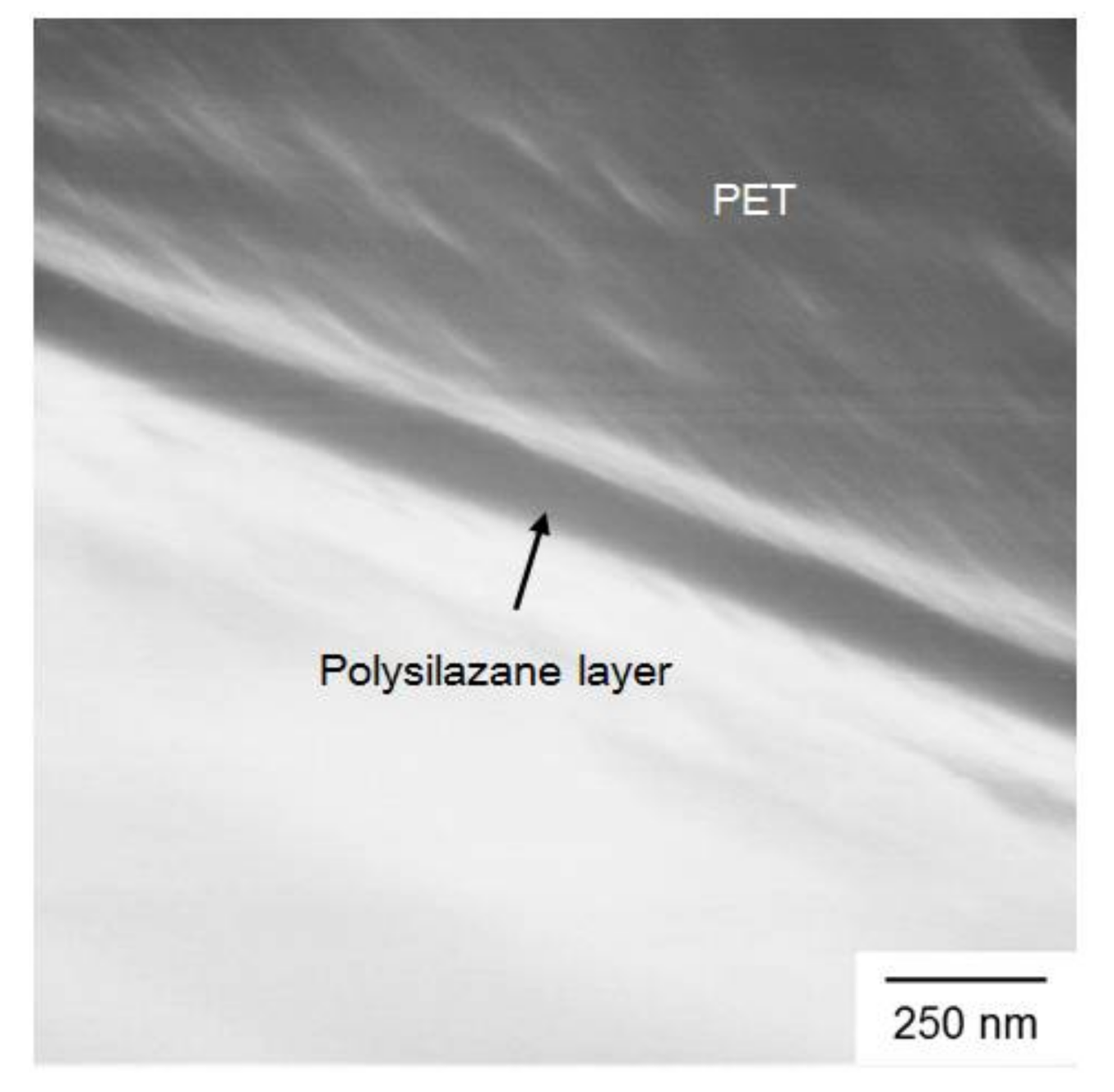
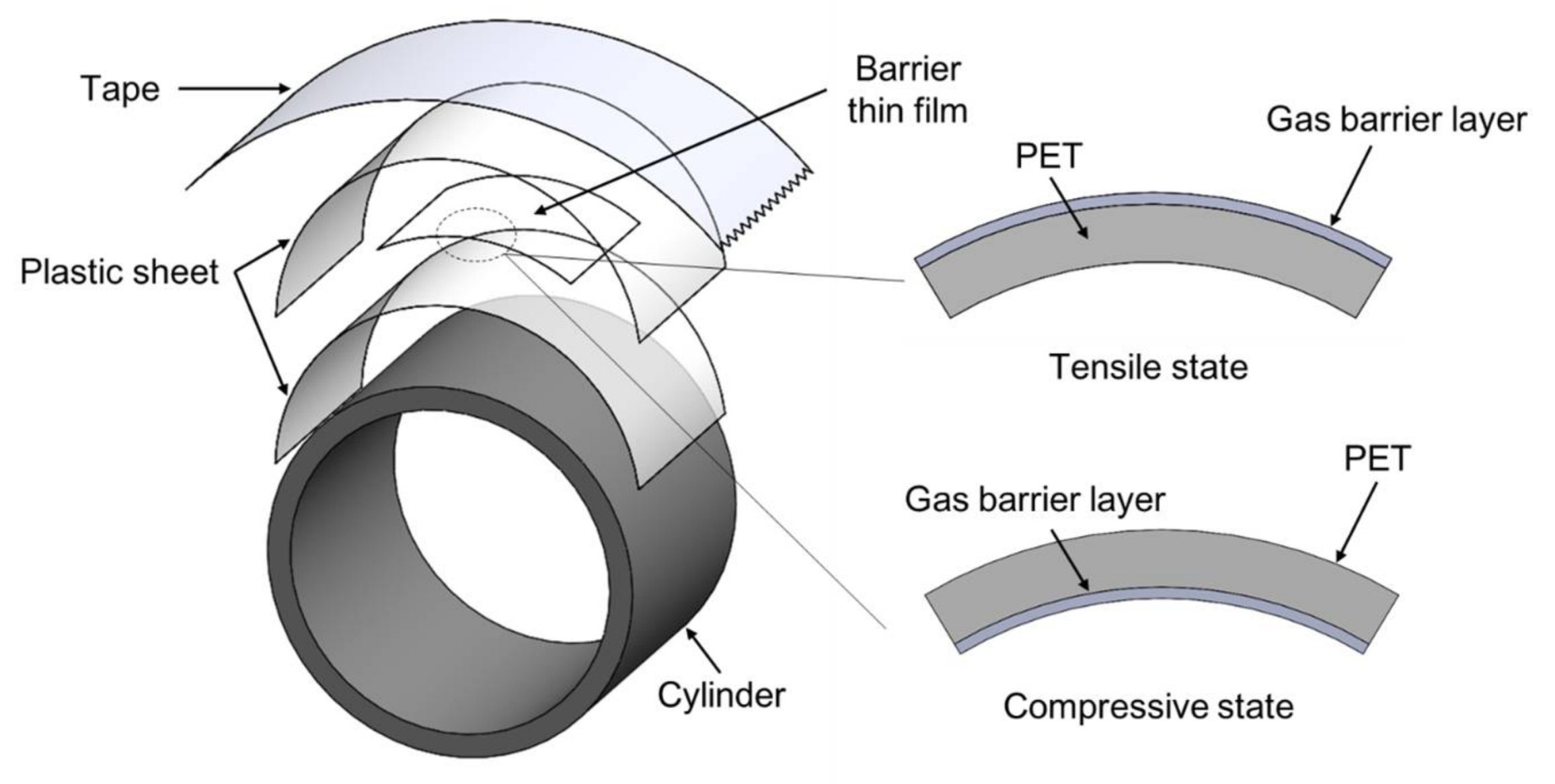
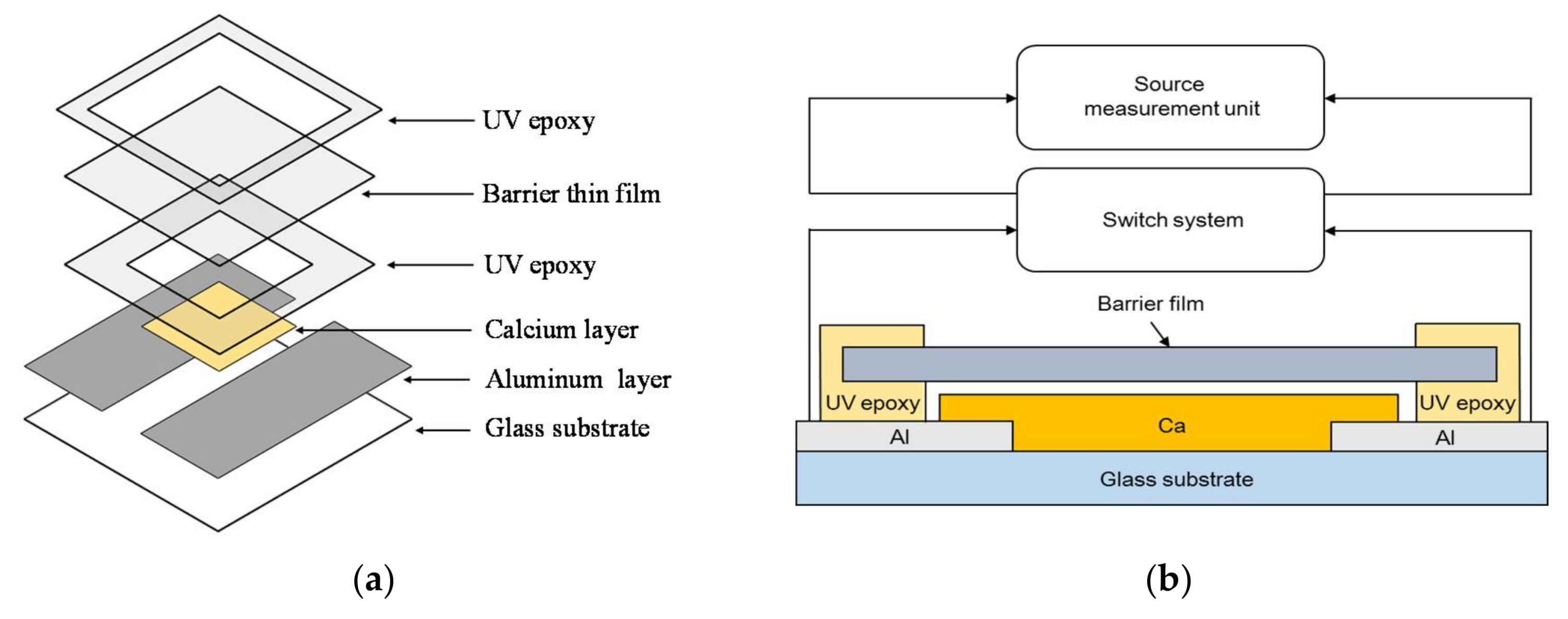
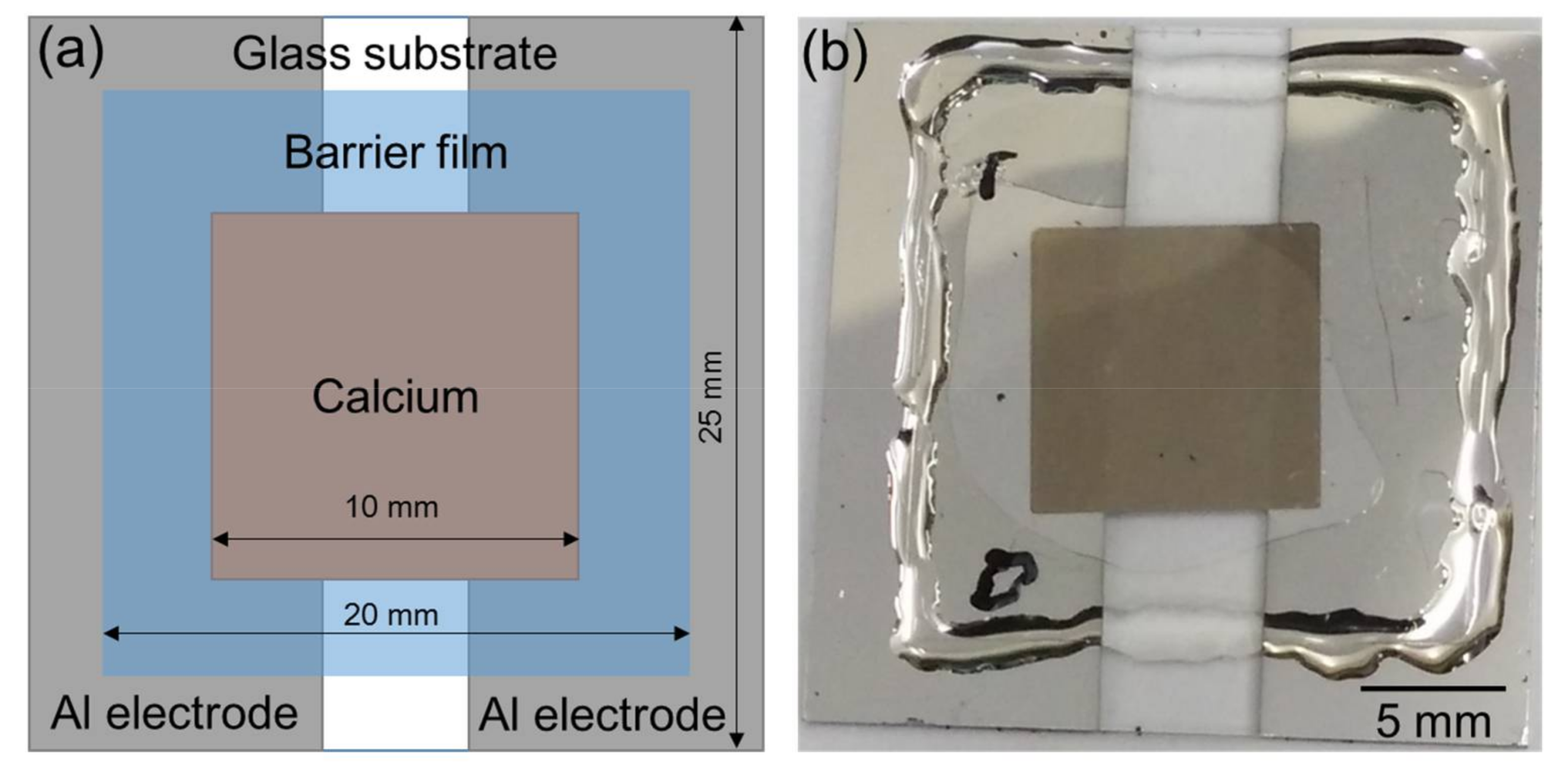
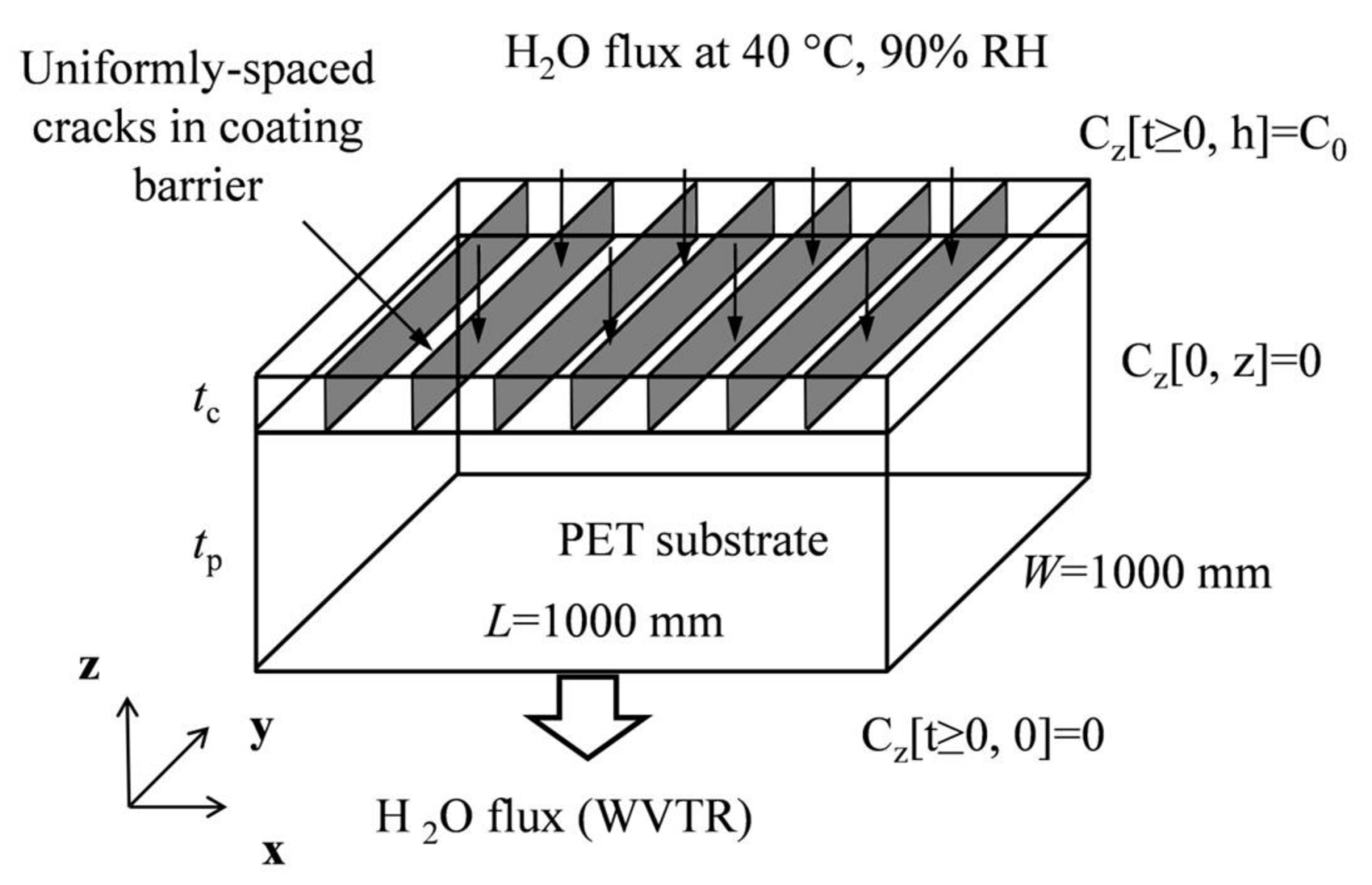
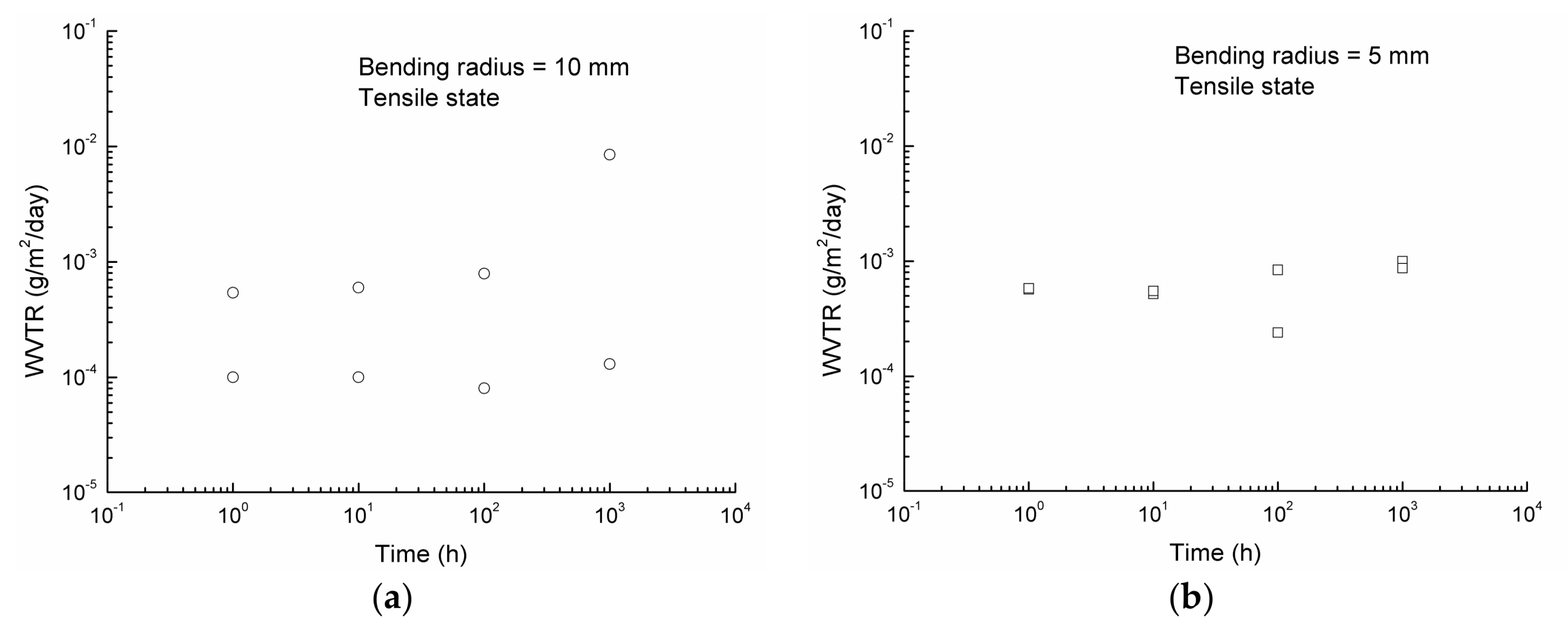
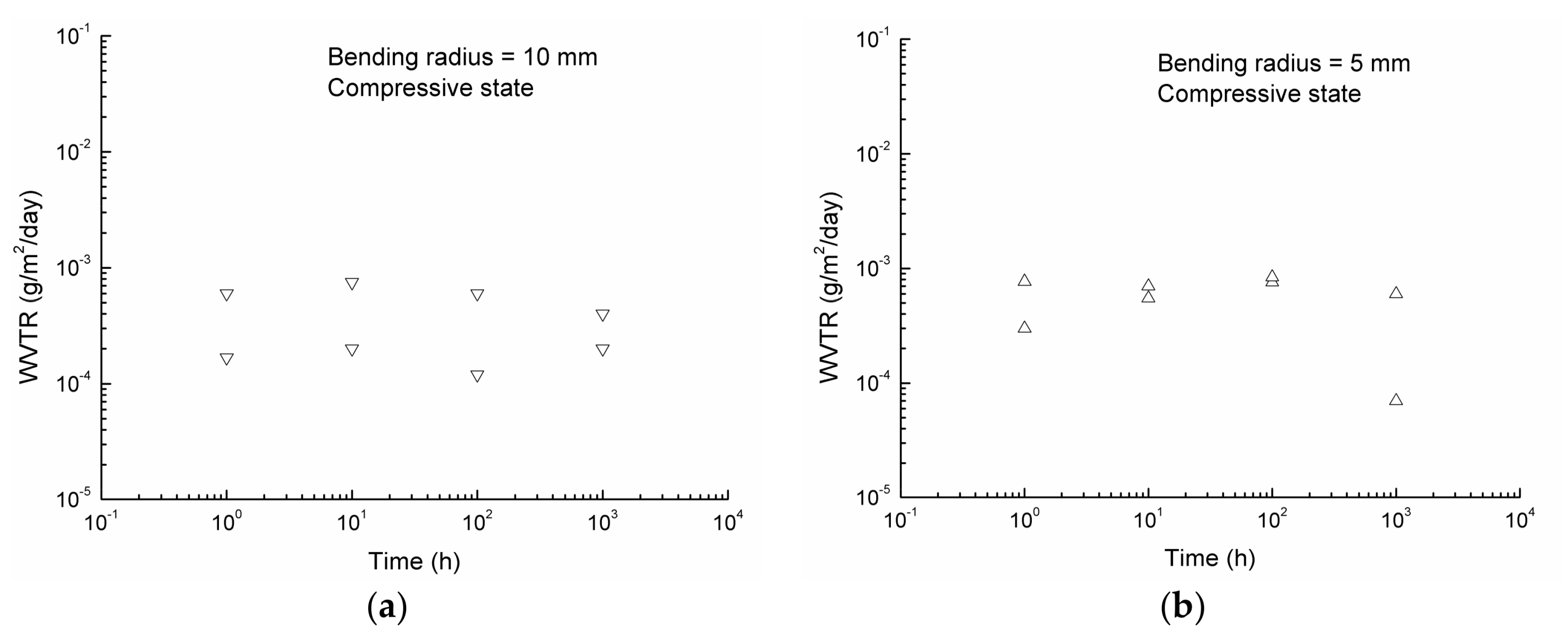
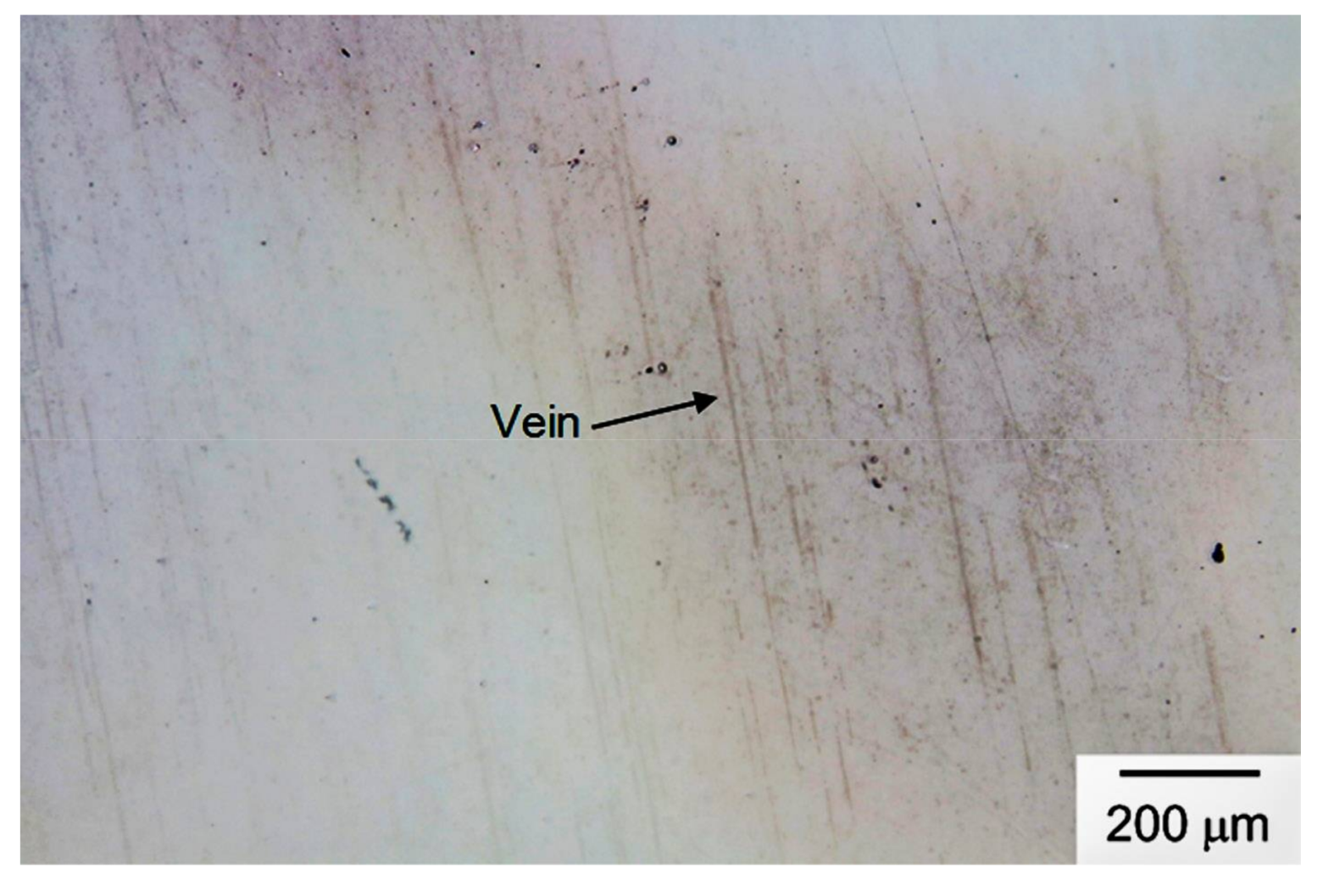

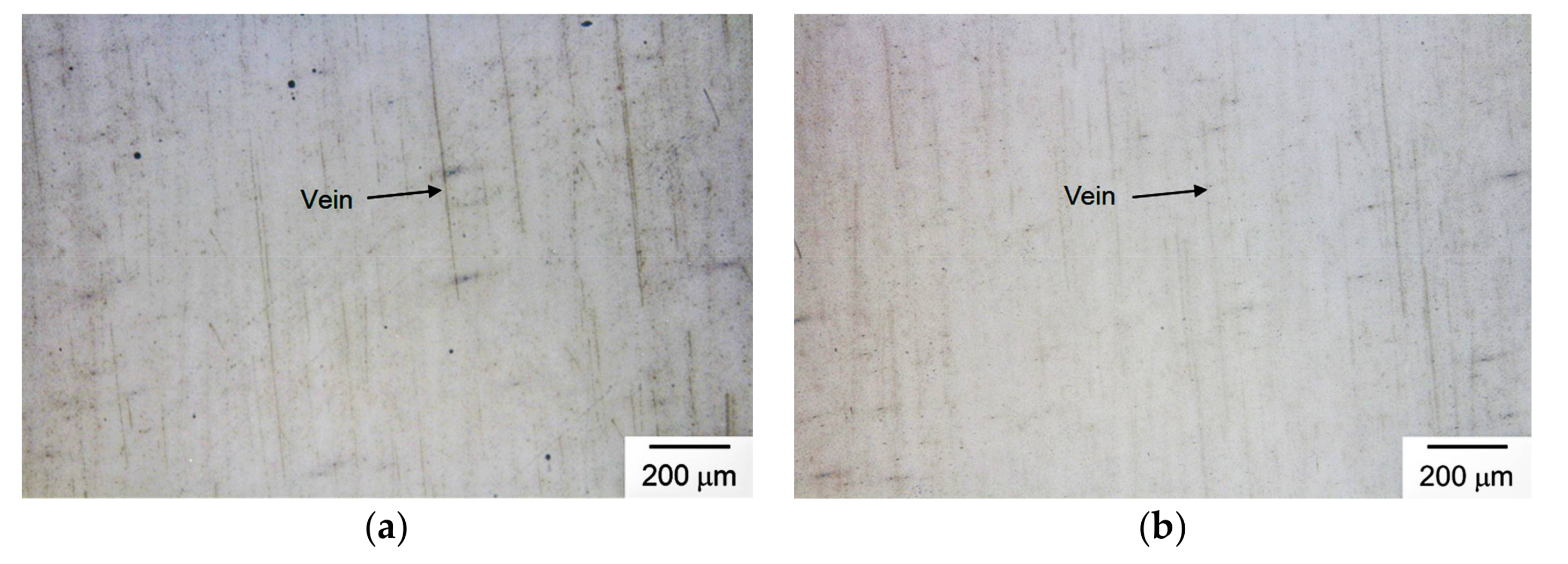
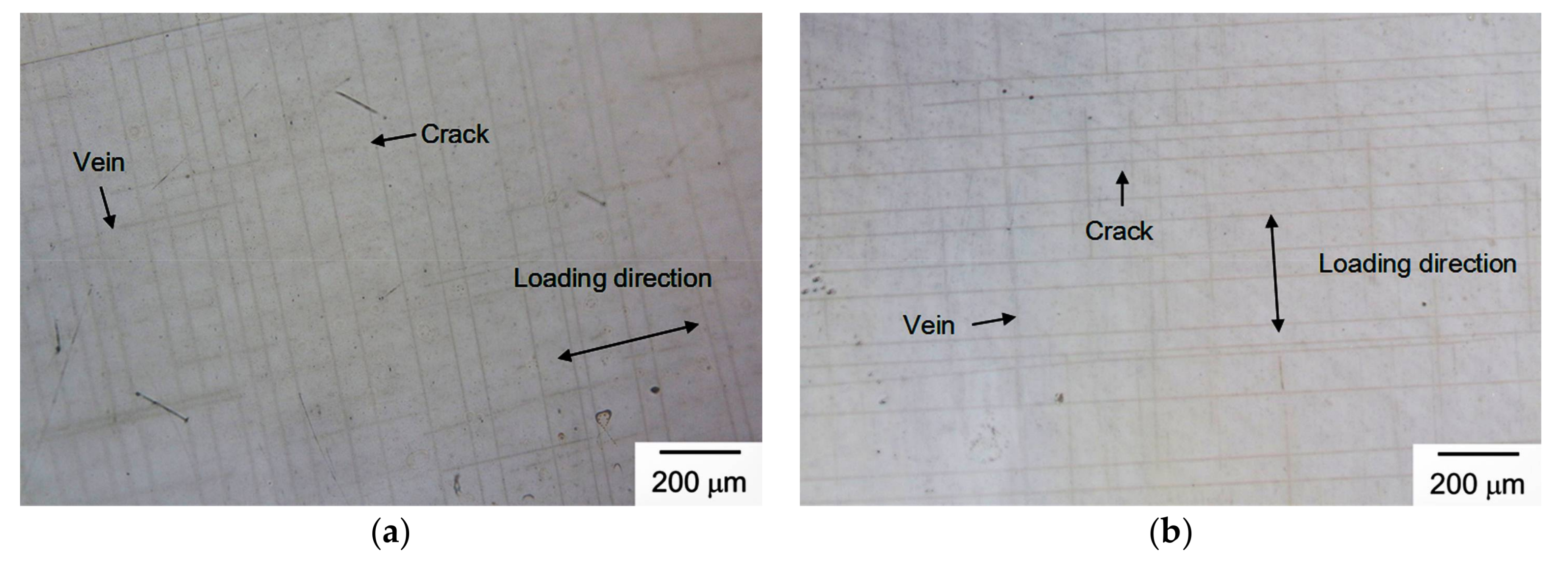

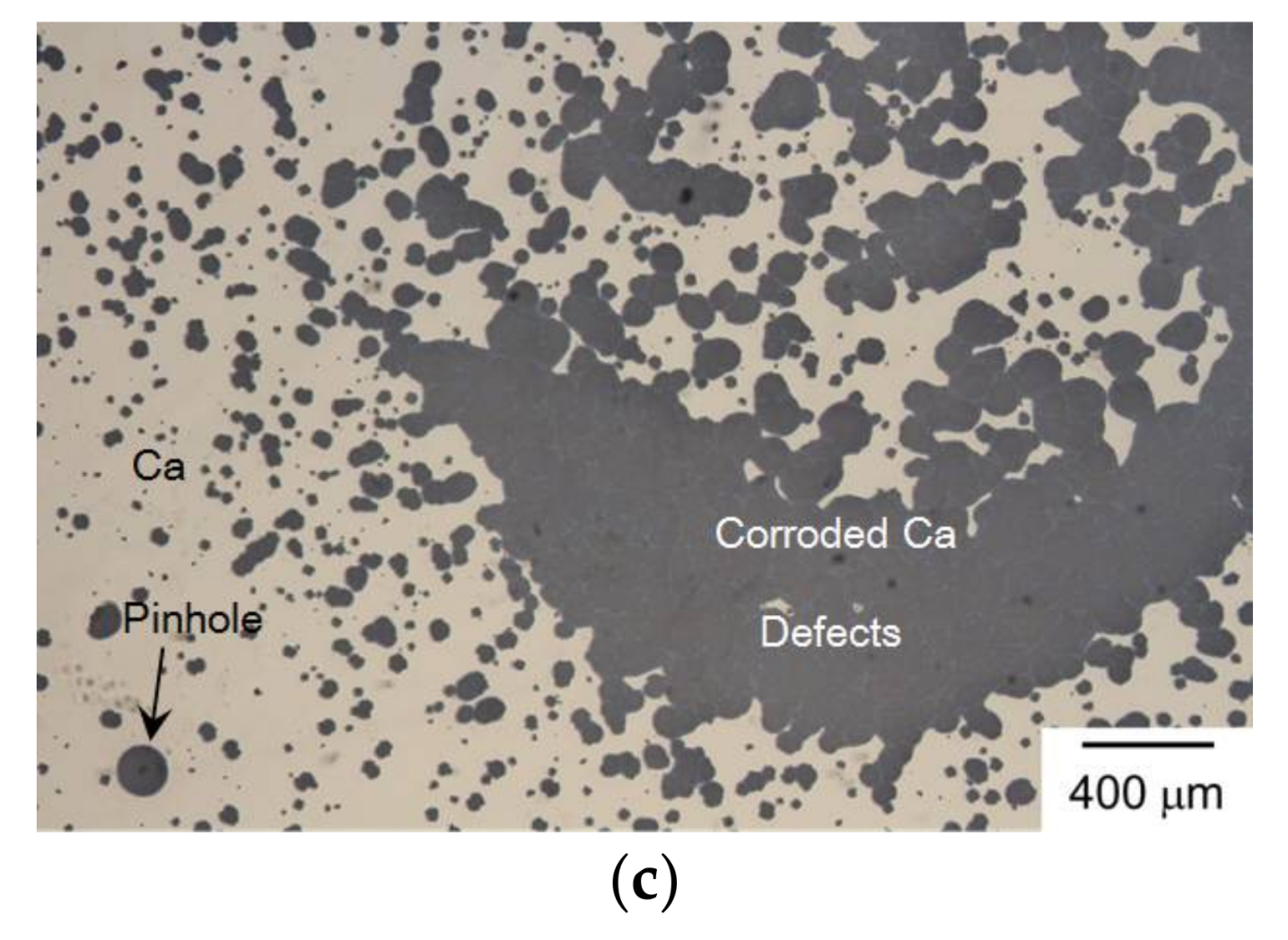
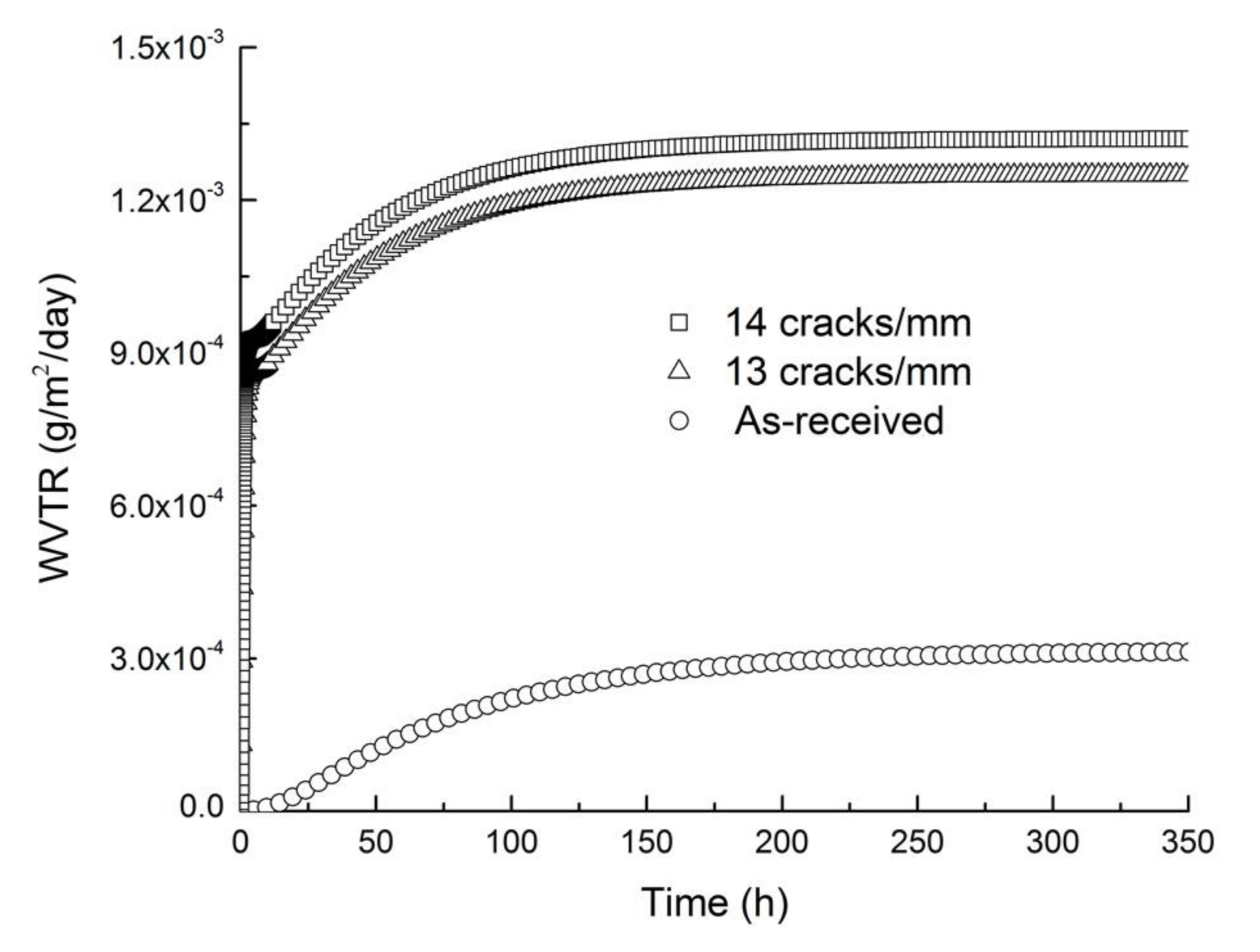
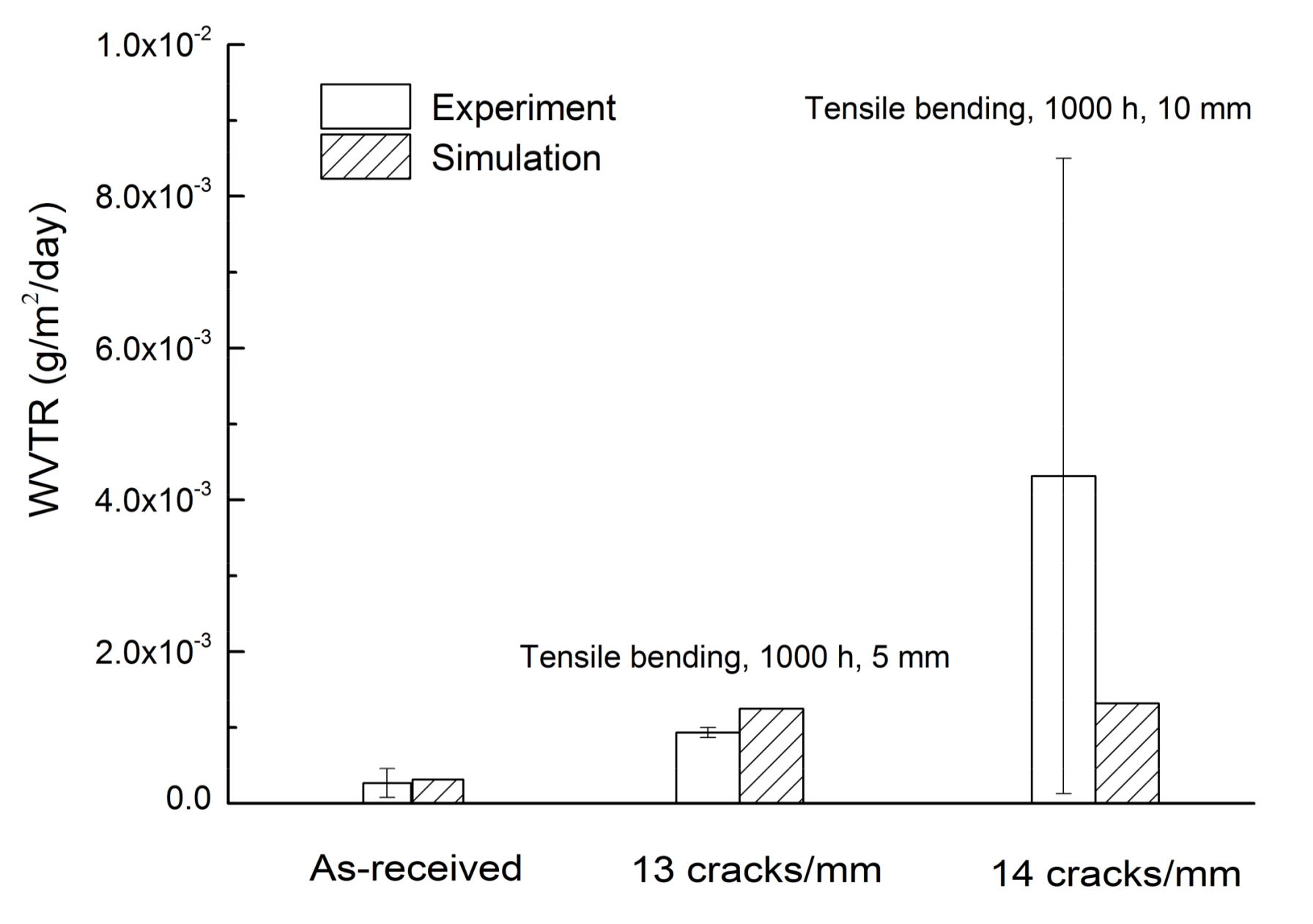
© 2018 by the authors. Licensee MDPI, Basel, Switzerland. This article is an open access article distributed under the terms and conditions of the Creative Commons Attribution (CC BY) license (http://creativecommons.org/licenses/by/4.0/).
Share and Cite
Lu, H.-I.; Tran, D.-P.; Lin, C.-K.; To, B.-D. Effects of Long-Term Static Bending Deformation on a Barrier Thin Film for Flexible Organic Optoelectronic Devices. Coatings 2018, 8, 127. https://doi.org/10.3390/coatings8040127
Lu H-I, Tran D-P, Lin C-K, To B-D. Effects of Long-Term Static Bending Deformation on a Barrier Thin Film for Flexible Organic Optoelectronic Devices. Coatings. 2018; 8(4):127. https://doi.org/10.3390/coatings8040127
Chicago/Turabian StyleLu, Hung-I, Dinh-Phuc Tran, Chih-Kuang Lin, and Bao-Dong To. 2018. "Effects of Long-Term Static Bending Deformation on a Barrier Thin Film for Flexible Organic Optoelectronic Devices" Coatings 8, no. 4: 127. https://doi.org/10.3390/coatings8040127



